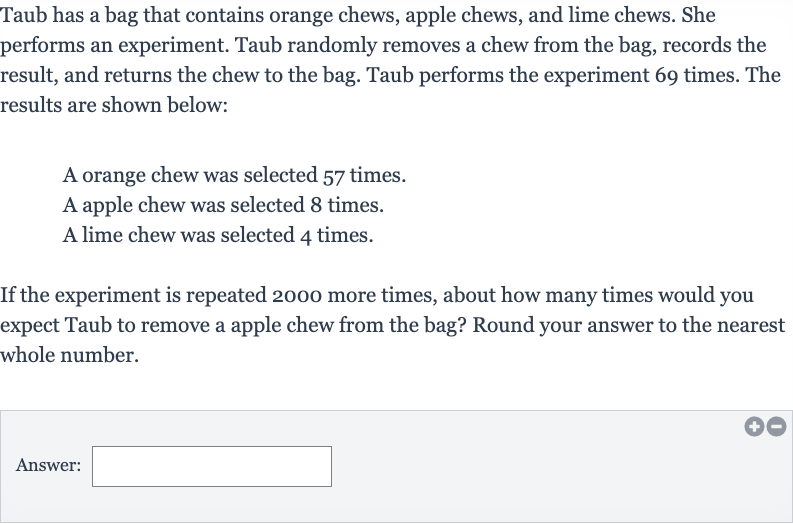AI tutor
Welcome to Bytelearn!
Let’s check out your problem:

Taub has a bag that contains orange chews, apple chews, and lime chews. She performs an experiment. Taub randomly removes a chew from the bag, records the result, and returns the chew to the bag. Taub performs the experiment times. The results are shown below:A orange chew was selected times.A apple chew was selected times.A lime chew was selected times.If the experiment is repeated more times, about how many times would you expect Taub to remove a apple chew from the bag? Round your answer to the nearest whole number.Answer:
Full solution
Q. Taub has a bag that contains orange chews, apple chews, and lime chews. She performs an experiment. Taub randomly removes a chew from the bag, records the result, and returns the chew to the bag. Taub performs the experiment times. The results are shown below:A orange chew was selected times.A apple chew was selected times.A lime chew was selected times.If the experiment is repeated more times, about how many times would you expect Taub to remove a apple chew from the bag? Round your answer to the nearest whole number.Answer:
- Calculate Probability: Determine the probability of selecting an apple chew based on the initial experiment.Taub selected an apple chew times out of total selections.Probability of selecting an apple chew Number of apple chews selected Total number of selectionsProbability of selecting an apple chew
- Estimate Selections in Experiments: Use the probability to estimate the number of times an apple chew would be selected in additional experiments.Expected number of times an apple chew is selected = Probability of selecting an apple chew Number of additional experimentsExpected number of times an apple chew is selected =
- Calculate Expected Selections: Calculate the expected number of times an apple chew is selected.Expected number of times an apple chew is selected = Expected number of times an apple chew is selected Expected number of times an apple chew is selected
- Round to Nearest Whole Number: Round the result to the nearest whole number, as the question asks for an estimate.Expected number of times an apple chew is selected (rounded to the nearest whole number)
More problems from Experiment design
QuestionGet tutor help
QuestionGet tutor help
QuestionGet tutor help
QuestionGet tutor help
QuestionGet tutor help
QuestionGet tutor help
QuestionGet tutor help
